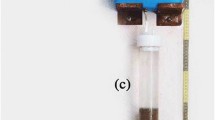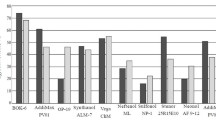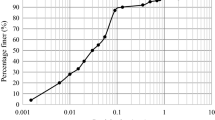Abstract
A crude contaminated soil, arising from an oil production zone in Tabasco, Mexico was studied. A sample of about 40 kg was dried and screened through meshes 10–100. Total petroleum hydrocarbons and 6 metals (Cd, Cu, Cr, Ni, V and Zn) were determined to the different portions. For soil which passed mesh 10, six non-ionic, three anionic and one zwitterionic surfactant solutions (0.5%) were employed to wash the soil. Additional tests using surfactant salt mixtures and surfactants mixtures were carried out. Once the best soil washing conditions were identified, these experimental conditions were applied for washing the rest of the soil portions obtained (meshes 4, 6, 20, 40, 60, 80, 100). Total petroleum hydrocarbons values were in the range of 51, 550 to 192, 130 mg/kg. Cd was not found in any of the soils portions, and the rest of the metals were found at different concentrations, for every soil mesh. Treatability tests applied to the soils indicated that it is possible to get removals between 9.1 to 20.5%. For the case of a sodium dodecyl sulphate 1% solution, total petroleum hydrocarbons removal was as high as 35.4%. Combinations of sodium docecyl sulphate and salts, gave removal rates up to 49.5%. Total petroleum hydrocarbons concentrations for the whole soil were about 150,600 mg/kg. The higher the particle size, the lower the washing removal rate. The combined effect of particle size and total petroleum hydrocarbons concentration, determines the total petroleum hydrocarbons removal efficiencies. These facts are very important for designing an appropriate soil washing remediation process.
Similar content being viewed by others
References
Chu W.; So, W.S., (2001). Modeling the two stages of surfactant-aided soil washing. Water Res., 35(3), 761–767.
Chu W.; Chan, K.H., (2003). The mechanism of the surfactantaided soil washing system for hydrophobic and partial hydrophobic organics. Sci. Total Environ., 307, 83–92.
Deshpande, S.; Shiau, B.J.; Wade, D.A.; Sabatini Harwell, J.H., (1999). Surfactant selection for enhancing ex-situ soil washing. Water. Res., 33(2), 351–360.
Kuhlman M.I.; Greenfield, T.M., (1999). Simplified soil washing process for a variety of soils. J. Hazar. Mat., 66, 31–45.
Iturbe, R.; Flores, C.; Chavez, C.; Gonzalez, A.; Torres, L.G., (2004a). In situ flushing of contaminated soils from a refinery: organic compounds and metal removals. Remediation, 141–152.
Iturbe R., C. Flores, C. Chavez, G. Bautista and L.G. Torres (2004b) Remediation of contaminated soil using washing and biopile methodologies at a field level. J Soils and Sed. 482, 115–122.
Lopez, J.; Iturbe, R.; Torres, L.G., (2004). Washing of soil contaminated with PAHs and heavy petroleum fractions using two anionic and one ionic surfactant: Effect of salt addition. J. Environ. Sci. Health. Part A., 39(9), 2293–2306.
Rodriguez, C.H.; Lowery, L.H.; Scamehorn, J.; Harwell, J.H., (2001). Kinetics of precipitation of surfactants. I. Anionioc surfactants with calcium and with cationic surfactants. J. Surf. Det., 4(1), 1–14.
SEMARNAT, (2003). Mexican Norm: NOM-138-SEMARNAT/SS-2003.
Stellner, K.L.; Scamehorn, J.F., (1989). Hardness tolerance of anionic surfactant solutions. 1. Anionic surfactant with added monovalent electrolyte. Langmuir., 5, 70–77.
Toeberman Ch.; Werther, J.; Rosenkrauz, J.; Gruhn, G., (1999) Flowsheet simulation of soil-washing process. Chem. Eng. Tech., 22(7), 558–567.
Torres, L.G.; Orantes, J.L.; Iturbe, R., (2003). Critical micellar concentrations for three surfactants and their diesel-removal efficiencies in petroleum-contaminated soils. Env. Geosc., 10(1), 28–36.
Torres, L.G.; Lemus, X.; Urquiza, G.; Verdejo, A.; Iturbe, R., (2005a). Surfactant enhanced washing of drilling fluids, a promising remediation technique. Tens. Surf. Det., 42(6), 347–355.
Torres, L.G., Aguirre, A.L.; Verdejo, A.; Iturbe, R., (2005b). Enhanced soil-washing treatment for soils which are highly contaminated with crude oil. WIT Transactions on Ecology and the Environment. Ecosystems and Sustainable Development V, 81, 541–550.
Torres, L.G.; Zavala, P.; Beltran, M.; Vaca, M.; Iturbe, R., (2006). Combination of natural gums and synthetic surfactants for washing of a soil highly contaminated with crude. Env.Geosc. In press.
Urum, K.; Pekdemir, T.; Ross, D.; Grigson, S., (2005). Crude oil contaminated soil washing in air sparging assisted tank reactor using biosurfactants. Chemosphere. 60, 334–343.
Yeh, K.C.; Young, Ch.Ch., (2003). Effects of soil fines and surfactant sorption on contaminant reduction of coarse fractions during soil washing. J. Env. Sc. Health. Part A., 38(11), 2697–2709.
Zhang, L.; Somasundaran, P.; Osokov, V.; Chou, C.C., (2001). Flotation of hydrophobic contaminants from soil. Coll. Surf. Part A., 177, 235–246.
Zhou, Q.; Sun, F.; Liu, R., (2005). Joint chemical flushing of soils contaminated with petroleum hydrocarbons. Environ. Int., 31(6), 835–839.
Author information
Authors and Affiliations
Corresponding author
Rights and permissions
About this article
Cite this article
Torres, L.G.B., Climent, M., Saquelares, J. et al. Characterization and treatability of a contaminated soil from an oil exploration zone. Int. J. Environ. Sci. Technol. 4, 311–322 (2007). https://doi.org/10.1007/BF03326288
Received:
Revised:
Accepted:
Published:
Issue Date:
DOI: https://doi.org/10.1007/BF03326288




